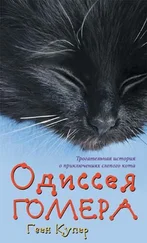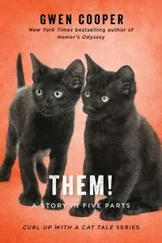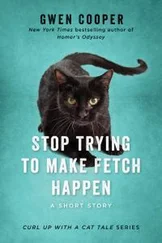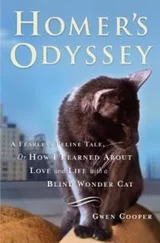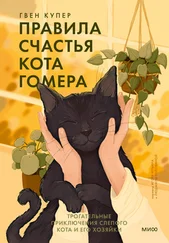I waited for my legs to stiffen, to feel my arm growing tired or the weight of Scarlett’s head becoming uncomfortable on my ankle. But that never happened. The warmth and drowsiness of Scarlett’s sleeping body seemed to seep into my own, and all I felt was a sense of balm. Balm and ease. The feeling that a tiny, twinging knot, which I’d lived with long enough to have stopped noticing it, had finally begun to loosen.
“Good Scarlett,” I murmured. “Good, good girl.”
We sat together like that, in the amber circle of lamplight, for a long time.
* * *
Things changed between us after that, although not dramatically, and not right away. Scarlett most certainly did not become a lap cat. She didn’t start running over whenever I called her. There was never a moment when Jorge looked at the two of us together and said, Look how affectionate Scarlett’s become! You’re a miracle worker!
In May of the following year, when Scarlett was a year old, we adopted another kitten—a tiny white fluff-ball only five weeks old, who’d been found wandering the streets of Little Haiti alone, near where my mother taught elementary school. My mother called me in tears over this half-starved, mite-ridden creature, who she couldn’t bring home with her but couldn’t bear to leave. So the kitten came to live with us, and I named her Vashti. Vashti was an affectionate cuddle-bug right from the start—and while Scarlett was initially a reluctant big sister, it wasn’t long before Vashti’s gentle sweetness won her over. Having a kitten to boss around put an end, once and for all, to Scarlett’s game of “let’s trip Mom and make her fall down!”
I don’t know when exactly it happened, although I do know that it was well before a month-old, permanently blind kitten named Homer, adopted more than a year after Vashti, came to complete our little family. Maybe it was seeing Vashti so frequently snuggled into my lap or curled up with me in bed that gave Scarlett the idea. But I began to notice how sometimes, waking up in the morning, I’d find Scarlett on our bed, fast asleep between my ankles. Or I’d be reading a book on the couch and Scarlett would come to stretch out across the top of the sofa behind my head—mercifully leaving my hair alone, but resting one small white paw on my shoulder and purring as she nodded off. Before Homer came to rewrite all the old rules, it was Scarlett who was the first to greet me at the door every day when I came home from work—even if she didn’t do much more than quickly brush her head against my ankles and then run off before I could pet her.
And it was Scarlett, when Jorge and I finally broke up for good after nearly four years together, who followed me as I got into bed that first, agonizing night, curling up on the empty pillow next to mine as I cried myself to sleep. When I awakened in the morning, feeling somehow warm and calm even as I remembered what had happened the day before, I realized that Scarlett was lying across my chest. Her heart beat against my own, and her head nuzzled into the crook of my neck as she purred gently into my ear. It was as if she’d known that the hardest thing about that first morning would be waking up by myself, and she was telling me that even without Jorge, I wasn’t alone.
Insofar as Scarlett became affectionate at all, it was only ever with me. Her disdain for humanity as a general concept would remain with her for the rest of her life. Scarlett was always the cat who immediately left the room when people came over, who would reject—with claws and teeth, if necessary—anybody else’s attempts to pet her. She would always be the cat who required an explanation. You shouldn’t touch Scarlett. You definitely shouldn’t try to pet Scarlett. Maybe it’s best if you don’t even look at Scarlett. After Jorge and I had ended things, when I lived for a few years on South Beach—and unexpectedly found myself part of a tightly knit, somewhat snobbish nightlife scene, whose glittering VIP rooms were closely guarded against any incursion by the “hoi polloi”—I would warn visiting friends, with a certain mock hauteur, “Scarlett is very exclusive.” And they would eye her with respect, grasping something fundamental—and, in its way, endearing—about Scarlett’s nature in far less time than it had taken me. It was, after all, undeniably flattering to be the one and only human permitted into a highly selective cat’s inner life.
All that’s jumping ahead, though. What did change immediately—right then on that November day when I picked up Scarlett at Jorge’s parents’ house—was my realization that Scarlett knew who I was, beyond just a hand that dispensed food or scooped out a litter box. She knew who I was to her . It mattered—more than either of us had known—that the hand feeding or cleaning up after her was my hand and nobody else’s.
Maybe Scarlett and I hadn’t “chosen” each other, exactly. There never was that one magical moment, the meeting of eyes, the resounding gong of two souls’ instant recognition of each other. What Scarlett and I had was, as it turned out, something far more elusive and enduring than that. It wasn’t the sort of thing that sprang up in a flash; it had to develop quietly, through months and years of love, patience, and growing trust.
The world may have been filled with other cats who would have come when I called or cuddled in my lap or slept every night next to me in bed. And it may also have been filled with other humans who could empty a can of food into Scarlett’s dish and then leave her alone, just as easily as I could.
At the rock-solid core of things, however, there was only one me for Scarlett, and there was only one Scarlett for me.
And that was enough. It was more than enough. It was everything.



